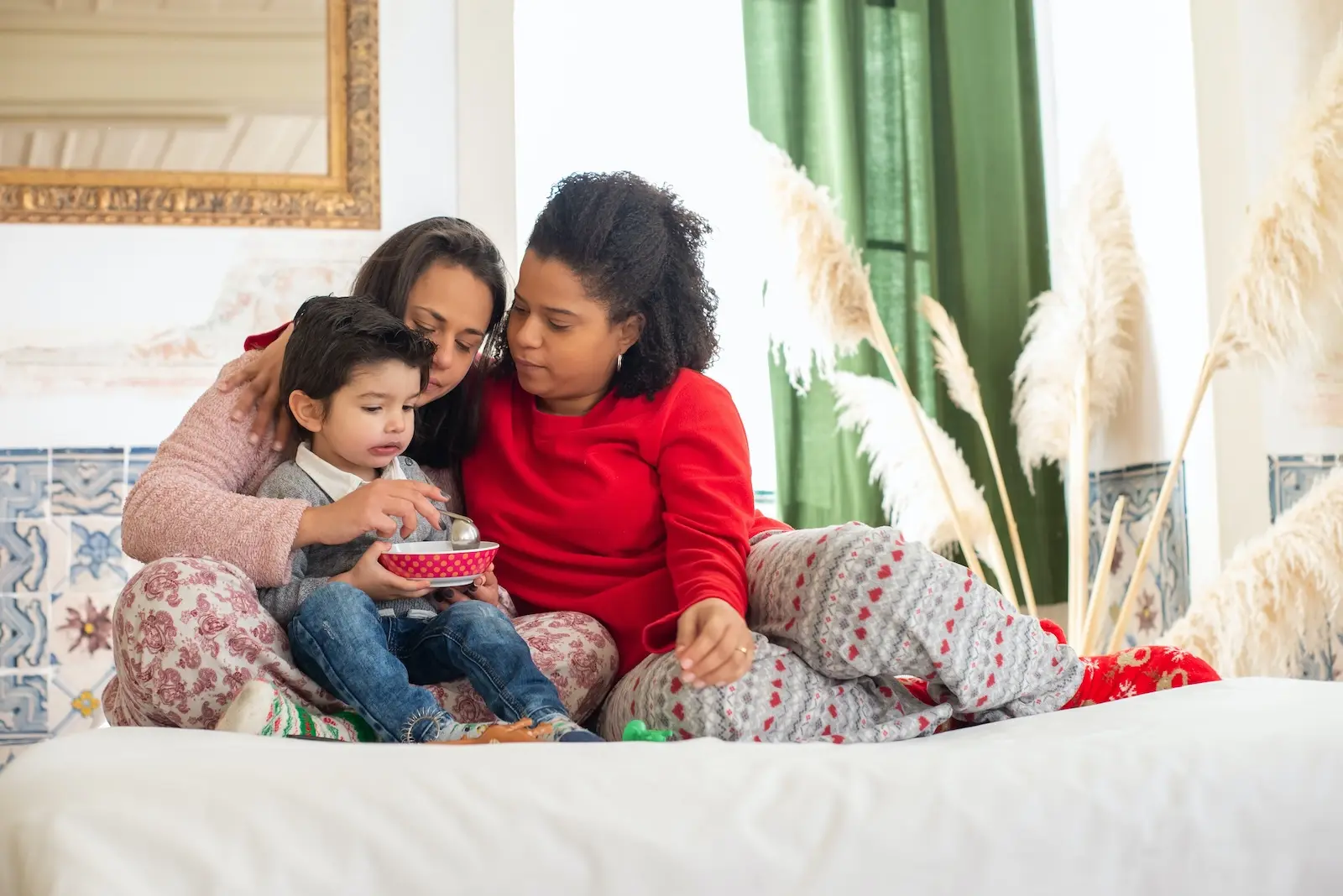settings
children
With Famly since
In the first of three articles on this issue, Fifi Benham and Shaddai Tembo introduce the concept of heteronormativity within the context of early education and explain how practitioners can best promote inclusive practice. Following this introductory article, articles two and three will explore how to have conservations with the child, examine the role of the material environment, and consider intersections with other protected characteristics.
To support accessibility, we’ve added a short glossary of the terms used at the bottom of this article.
For various reasons, the issue of heteronormativity tends to gather less attention in conversations about equality in early childhood. Yet understanding this term is important for practitioners to better develop ways to counter LGBTQ+ inequalities in the early years.
The big ideas
Heteronormativity is a concept that refers to the assumption in a society of heterosexuality as the default sexual orientation. It is an assumption because, while we often see our identities as fixed in place from birth, or natural, research shows that it is often societal influences that shape who we are and become.
Why does heteronormativity matter in the Early Years?
Heteronormativity is premised on a binary understanding of gender and relationships:
- that the only two genders are ‘men’ and ‘women’,
- and that relationships should typically be between one person from each of those groups.
It is harmful to LGBTQ+ people as it means that they have to work against an assumed reality, as opposed to more diverse concepts of gender and relationships being accepted as possibilities.
Although heteronormativity grants cisgender heterosexual people a significant level of privilege, it can also cause them harm through the expectation of distinct gender roles both in relationships and in wider society.
Unlearning heteronormativity is therefore essential in striving for equity and social justice in the early years.
The impact of heteronormativity in early childhood can be seen in the ways society expects, either implicitly or explicitly, girls and boys to dress, behave and play in separate yet complementary ways. For example, girls being given dolls to look after and boys being expected to enjoy ‘rough and tumble play, or when an offhand comment is made that a boy has a ‘crush’ or ‘fancies’ another girl.
There is then a presumed path of a future relationship with someone from the 'opposite' gender, and a set of expectations about what each person should bring to that relationship. For example, even before babies are born the first clothes, toys, and bedrooms prepared for them will be designed to fit a stereotype of what a boy or a girl should like.
Slogans such as "Ladies man," and "Sorry boys, daddy says I can't date until I'm 30," are unfortunately not uncommon on baby grows and children's clothes. This is often overlooked as being playful and innocent but the sexualisation of babies and children as well as the expectation of heterosexuality it sets can be deeply harmful.

Underpinning practice through policy and guidance
Whilst current early years guidance does not explicitly mention heteronormativity, there are broader statements and advice which do apply. . This begins in the EYFS (2021) which underpins the obligations of all settings to adhere to the Equality Act 2010.
Development Matters
Development Matters (2021) states in the key features of effective practice that "all children deserve to have an equal chance of success."
This is relevant in that heteronormativity perpetuates outdated ideas about skills and jobs being suited to one specific gender. In order for children to have an equal chance of success, practitioners must create a space where exploration of different futures is not restricted in this way.
Development Matters guidance on Understanding the World includes avoiding "songs which include gender, cultural or racial stereotypes." Gender stereotypes, in particular, relate to heteronormativity as, in rhymes or songs for young children, they will often refer to mummies and daddies doing different activities or filling different roles.
An obvious example here is the “mummies going chatter chatter chatter” in the rhyme ‘The Wheels on the Bus’ while the “daddies read the news”. Rhymes like this perpetuate particular stereotypes about men and women that should be avoided.
The guidance also includes supporting children's understanding and exploration of people's differences using "materials which confront gender stereotypes." This makes it clear that best practice goes beyond just not perpetuating stereotypes but necessitates actively confronting them.
Birth to 5 Matters
Birth to 5 Matters (2021) also has a section on inclusive practice and equality, explicitly naming sexual orientation as a protected characteristic. Specific emphasis is placed on ensuring children see themselves and their families represented.
An example of the ways this document builds upon guidance set out in Development Matters is that Birth to 5 advises our resources must "avoid stereotypical depictions of people based on gender and sexual orientation." This more clearly links to heteronormativity by suggesting different sexual orientations should also be fairly represented.
It is also stated that "practitioners should share their willingness to challenge stereotypes and misunderstandings." This promotes individual practitioners taking responsibility for actively addressing these issues as they arise. Although the statement is not specific to any one type of stereotype this guidance can be applied as a willingness to challenge heteronormativity.
Acknowledging heteronormativity in your practice
Central to challenging heteronormativity is firstly making sure that you, as a practitioner, are prepared to have these conversations and are to reflect on your practice.
As noted earlier, this is an issue that tends to gather less attention in discussions on equalities, often because of:
- denial that it matters (“children surely aren’t learning about these things”),
- a wish to keep childhood ‘innocent’ (“we shouldn’t worry children with these issues”),
- or the fear of getting it wrong (“what if I offend someone?”).
While we’ve made clear that this clearly is a fundamental issue in the early years, the fear of getting it wrong has to be weighed against the implications of not engaging with this work at all. Nobody is perfect and it is likely that you will make mistakes, as in every single other aspect of life. What’s important here is that you are committed and open to learning and having these conversations. Initially, it’s a good idea to review your internal equality and inclusion policies.
Internal equality and inclusion policies.
Equality and inclusion policies must set out clear expectations of practice that allows all children the chance to play and explore outside cisheteronormative expectations. This means not just stating the need to adhere to the Equality Act 2010 but expanding upon the way stereotypes negatively impact children's opportunities and how this may be countered. This is a shift from reactive to proactive thinking.
Having clear systems in place for staff meetings, supervision and CPD must aim to provide opportunities for progress to be made. Consistency amongst staff teams in their understanding of heteronormativity and how to tackle it is one way to ensure children are given equal opportunities to thrive.
If you don’t feel comfortable addressing this internally, it’s worth seeking the support of an external trainer to support developing a strategy. If perpetuating heteronormativity is repeatedly an issue with staff then it may be best to revisit the setting's policies and how to ensure they are followed.

What if something prejudiced or discriminatory is said?
Practitioners must be prepared to have open discussions when something is said by either a parent or a colleague within the setting that perpetuates heteronormativity.
But how do you do this?
How to handle that situation will depend on a number of factors, such as
- whether it is a conversation with children or with colleagues.
- whether it is appropriate to address the situation at that exact moment
- whether the practitioner themselves feels they are emotionally safe to challenge what’s been said.
An example might be that something upsetting is said by a parent rooted in prejudice. It might during drop-off or pick-up times, when they see their child in a dress or pushing a buggy, that they might say ‘they shouldn’t be doing that’ or they ‘should be doing something else’.
Practitioners need to look after their own well-being and shut down the conversation until they are prepared to respond with the support of the setting.
Asking questions which encourage breaking down what is said is often key to helping others re-evaluate both the truth of their statement and whether they even believe it themselves. Working through prejudices together is more likely to create genuine change, rather than the burden being placed on the individual educator to respond in each situation.
Overall, recognising and actively challenging heteronormativity is key to ensuring all children have the same freedom of opportunity.
Learning about the key terms, how this issue sits with policy and understanding how to begin these conversations with parents and colleagues is an important initial step. In the second article, we will consider how to have conversations with the child and think about the broader material environment.
Glossary
Gender
Gender can be understood as a social system of practices, norms and expectations within society that characterise people as different in socially significant ways, typically based upon masculinity and femininity.
Cisgender
A term that describes someone whose gender identity aligns with the sex the person was identified as having at birth.
Transgender
A term that describes someone whose gender identity does not align with the sex the person was identified as having at birth.
Non-binary
A term that describes someone whose gender identity sits outside the gender binary system, which itself infers the belief that there are only two gender identities.
Heteronormativity
A concept used to describe practices that socially exclude or marginalise non-heterosexual people and preserve heterosexuality as the norm
Homophobia
Discrimination or prejudice against homosexuality or gay people.
LGBTQ+
An umbrella term to refer to all current and future minoritised sexual orientations and gender identities, with the plus symbol used as a proxy to represent both the wide variety of established genders and orientations beyond the initialism and those who are part of the community but have a more fluid sense of identity and do not necessarily feel drawn to particular labels.
Sexual orientation
Describes people’s emotional attraction or desire toward others.
Transphobia
Discrimination or prejudice against trans people.
Get 1000s of free EY activities
Want over 7,000 activities? See them in a free 14-day trial. Filter to target learning areas, age groups and topics, and get inspired.
Get started









